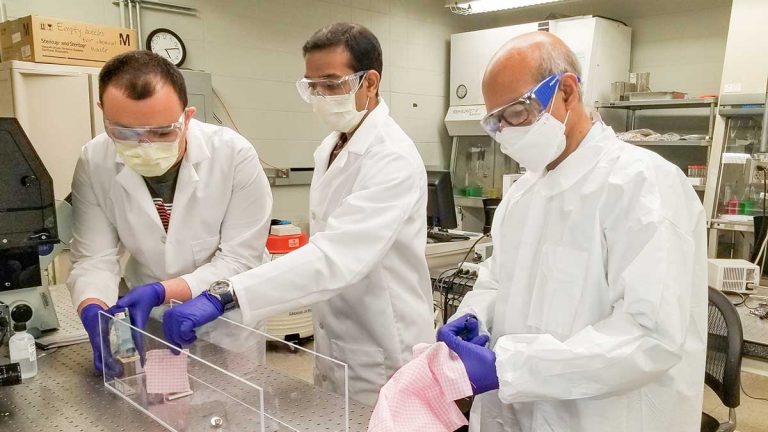URBANA – When choosing a mask or face covering to wear during the pandemic, research from the University of Illinois at Urbana-Champaign suggests that a well-fitted mask made of two layers of a breathable material can be nearly as effective as a surgical mask at blocking respiratory droplets, which are released when people cough, sneeze and talk.
Masks and face coverings are mandated in public settings in many states, including Illinois.
Such laws are based on guidance from the U.S. Centers for Disease Control and Prevention, which draws from research studies showing common fabrics used in cloth masks are effective at reducing the spread of droplets that can carry viruses from people who have COVID-19, regardless of symptoms.
Among those studies is one that was led by U of I mechanical engineering professor Taher Saif. The research is now published in the journal “Extreme Mechanics Letters.”
Using a setup in the lab, Saif’s team tested 11 cloth materials, including both cotton and polyester blends from T-shirts, bed sheets and dishcloths. The researchers studied how well the materials block respiratory droplets carrying nanoparticles that are roughly the size of the coronavirus, traveling at a similar speed to droplets emitted when people cough, sneeze and talk.
The team then compared the performance of the household materials with surgical mask material.
Saif says all single-layered materials tested blocked at least half of droplets released, and with two layers, the efficiency increased to more than 90% — comparable to the performance of surgical masks.
“Then the question is: I have good breathable material; Now how do I design a mask so that I don’t create big open spaces? And that’s where the creativity comes,” Saif says.
The most effective masks, he says, are made of a breathable material and have a good fit around the face, covering the mouth and nose. The fit is important to make sure droplets don’t escape out the sides of the mask.
Saif says his research on the effectiveness of materials at blocking respiratory droplets — which are large enough to fall to the ground quickly — complements other studies on the use of cloth materials for blocking the transmission of aerosols, which are smaller and can linger in the air.
The CDC and World Health Organization say the coronavirus spreads primarily through respiratory droplets when people are in close contact, and aerosols play a “minor role,” Dr. Ali Khan, a former CDC official, tells NPR.
Saif says the body of research on the effectiveness of cloth masks presents “strong scientific evidence that if we replace the surgical mask with cloth, as long as there are two layers, they give you very similar protection.”
His advice: wear a mask that’s comfortable, “and let it be part of life for quite some time to come.”
The CDC offers additional guidance on its website for making, wearing and washing cloth masks.
If you have a question you would like Illinois Newsroom to address regarding COVID-19, submit it here.
Christine Herman is a reporter with Illinois Newsroom. Follow her on Twitter: @CTHerman

